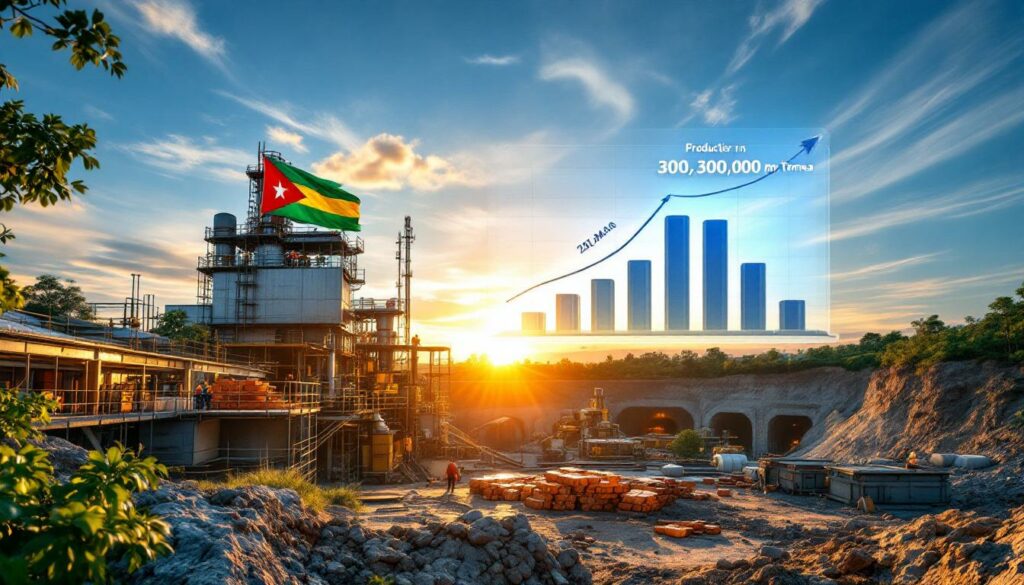Vedanta's Zambian Copper Mine Renovation: A Transformative Investment
Konkola Copper Mines (KCM) is undergoing a major transformation under Vedanta Resources' leadership, with a comprehensive smelter renovation that promises to revitalize Zambia's copper industry. This strategic investment aims to dramatically increase production capacity while addressing long-standing technical challenges that have limited the mine's output for years.
What is Konkola Copper Mines' Renovation Plan?
Vedanta Resources has embarked on an ambitious renovation plan for KCM's copper smelter facilities in Zambia. According to a July 2025 statement from KCM reported by Shanghai Metal Market (SMM), the renovation involves a "complete shutdown and renovation" of the smelter complex to "restore structural integrity and improve efficiency" across all operational components.
The renovation isn't merely a maintenance project—it represents a comprehensive overhaul designed to transform KCM's production capabilities. Engineers will focus on reinforcing critical infrastructure, replacing worn components, and implementing advanced smelting technologies that align with global standards.
The Scope of KCM's Smelter Renovation Project
The renovation encompasses several critical aspects:
- Complete infrastructure assessment and reinforcement of existing smelter foundations
- Replacement of outdated refractory linings that have deteriorated over time
- Modernization of furnace systems to improve heat efficiency and reduce energy consumption
- Installation of advanced emissions control technology to meet international environmental standards
- Optimization of material handling systems to reduce bottlenecks in production flow
This multifaceted approach addresses not just immediate structural concerns but positions KCM for long-term operational excellence within Africa's copper industry.
Production Targets and Current Performance Gaps
The disparity between KCM's current production and its ambitious targets reveals the necessity of this renovation:
- Current production: Less than 30,000 metric tonnes annually (below 10% of target capacity)
- Target production: 300,000 metric tonnes by the early 2030s
- Production gap: Approximately 270,000 metric tonnes to reach full potential
"The current production gap represents not just a technical challenge but a significant economic opportunity for both Vedanta and Zambia's mining sector," notes the SMM report from July 2025.
This tenfold increase in production capacity would not only transform KCM's financial prospects but significantly enhance Zambia's position as Africa's second-largest copper producer.
How Did Vedanta Regain Control of KCM?
The renovation project follows Vedanta's successful resolution of a protracted ownership dispute with Zambian authorities, culminating in the company regaining operational control approximately one year ago (mid-2024). This settlement marked the end of a contentious period that had hampered investment and development at one of Zambia's most significant mining assets.
Resolution of the Zambian Government Dispute
The dispute centered around complex issues of:
- Regulatory compliance and operational performance
- Investment commitments and development timelines
- Environmental management concerns
- Economic benefits distribution to local communities
The resolution process involved extensive negotiations between Vedanta executives, Zambian mining officials, and legal representatives from both sides. While specific details of the settlement remain confidential, the outcome restored Vedanta's operational authority while establishing new frameworks for accountability and national economic benefit.
Financial Commitments Following Acquisition
Vedanta has demonstrated its serious commitment to KCM's revitalization through substantial financial investments:
| Investment Category | Amount (USD) | Percentage of Total |
|---|---|---|
| Debt Repayment | $250 million | 62.5% |
| Installment Payments | $124 million | 31% |
| Other Investments | $26+ million | 6.5% |
| Total Investment | $400+ million | 100% |
According to SMM reporting, the majority of these funds have been directed toward underground mining operations at Konkola, addressing immediate operational needs while the smelter shutdown impact plan was being developed.
This strategic allocation reflects Vedanta's balanced approach—stabilizing financial obligations while simultaneously investing in productivity improvements that will generate future returns.
Why is This Renovation Significant for Zambia's Copper Industry?
The KCM renovation represents more than just a single company's production upgrade—it has profound implications for Zambia's entire copper sector and broader economy.
Zambia's Position in Global Copper Markets
Zambia holds a crucial position in the global copper supply landscape:
- Ranks as Africa's second-largest copper producer after the Democratic Republic of Congo
- Contributes significantly to global copper supply chains, particularly for manufacturing and renewable energy sectors
- Faces increasing competition from emerging copper producers in Asia and South America
The country's mining sector has struggled with processing limitations that have forced policy adaptations. In June 2025, Zambia exempted 255,000 metric tonnes of copper concentrates from export taxes—a direct response to insufficient domestic smelting capacity, including KCM's technical limitations.
This tax exemption highlights the interconnection between processing infrastructure and national economic policy. With enhanced smelting capacity at KCM, Zambia could potentially process more copper domestically, retaining greater economic value within the country.
Economic Impact of Enhanced Production Capacity
The KCM renovation promises substantial economic benefits:
- Direct employment generation: Hundreds of skilled jobs during renovation and thousands more when operating at full capacity
- Indirect employment: Thousands of additional jobs throughout the supply chain and service sectors
- Tax revenue enhancement: Increased production will expand the tax base through royalties and corporate taxes
- Foreign exchange earnings: Greater export capacity improves Zambia's trade balance and currency stability
- Skills development: Technology transfer opportunities for the local workforce
"The multiplier effect of mining investments like KCM's renovation extends far beyond the mine gates, creating economic activity throughout regional economies," notes mining economist Dr. Nathan Kapembwa in a related industry assessment.
By addressing the production bottleneck at KCM, Vedanta's investment could help unlock Zambia's fuller potential as a copper producer on the global stage.
What Technical Challenges Must KCM's Renovation Address?
The ambitious production targets for KCM can only be achieved by overcoming significant technical obstacles that have limited output for years.
Current Smelter Limitations and Inefficiencies
The existing smelter operation faces multiple constraints:
- Structural deterioration: Years of intensive operation have compromised key structural components
- Energy inefficiency: Outdated furnace systems consume excessive power relative to output
- Process bottlenecks: Material handling limitations restrict throughput capacity
- Recovery rates: Lower-than-industry-standard metal recovery from ore concentrates
- Maintenance requirements: Frequent unplanned downtime due to equipment failures
These technical deficiencies have created a situation where KCM's current production remains below 30,000 metric tonnes annually—less than 10% of its target capacity. The efficiency gap represents both a challenge and an opportunity for the renovation project.
Modernization Opportunities Through Renovation
The comprehensive renovation allows KCM to implement several technological advancements:
- Flash smelting technology to increase processing efficiency by up to 30%
- Heat recovery systems to capture and repurpose thermal energy
- Advanced automation and control systems for process optimization
- Improved emissions capture technology to reduce environmental impact
- Enhanced material handling systems to eliminate production bottlenecks
These improvements align with global best practices in copper smelting operations and could potentially position KCM as a regional leader in metallurgical efficiency once completed.
How Does This Investment Compare to Other Copper Mining Projects?
Vedanta's $400+ million investment in KCM represents a significant financial commitment that must be evaluated in the context of global copper investment insights.
Capital Investment Benchmarking
While substantial, KCM's renovation investment falls in the mid-range of recent copper mining developments:
| Project | Company | Investment (USD) | Scope |
|---|---|---|---|
| KCM Renovation | Vedanta | $400+ million | Smelter renovation and mine improvement |
| Quellaveco (Peru) | Anglo American | $5.3 billion | New mine development |
| Kamoa-Kakula (DRC) | Ivanhoe Mines | $1.3 billion | Mine expansion |
| Spence (Chile) | BHP | $2.5 billion | Mine extension |
The investment appears well-calibrated to KCM's specific needs, focusing on maximizing return through targeted infrastructure improvements rather than new mine development.
Strategic Value Within Vedanta's Global Portfolio
For Vedanta Resources, the KCM renovation represents:
- Portfolio diversification across multiple geographies and resource types
- Leveraging existing assets to maximize return on historical investments
- Strategic positioning in copper markets ahead of projected demand growth
- Long-term commitment to the Zambian mining sector
The company's willingness to allocate significant capital after resolving the ownership dispute demonstrates confidence in both the technical feasibility of the renovation and the long-term economic viability of Zambian copper production.
What Are the Environmental and Social Implications?
Modern mining investments must balance production goals with environmental responsibility and social impact—areas where KCM's renovation presents both challenges and opportunities.
Sustainability Considerations in Smelter Renovation
The renovation offers several potential environmental improvements:
- Reduced emissions intensity through modern filtration and capture systems
- Improved energy efficiency reducing carbon footprint per tonne produced
- Enhanced water management systems minimizing consumption and contamination risks
- Waste reduction through improved recovery rates and processing efficiency
- Alignment with international standards such as the Copper Mark responsible production framework
These environmental enhancements are increasingly important not just for regulatory compliance but also for market access, as downstream buyers increasingly demand responsibly sourced materials.
Community Impact Assessment
The social dimensions of the renovation extend beyond the mine site:
- Local procurement opportunities during construction phase
- Skills development programs for community members
- Infrastructure improvements benefiting surrounding communities
- Health and education initiatives as part of corporate social responsibility
- Stakeholder engagement processes to address community concerns
Vedanta has an opportunity to implement best practices in community engagement throughout the renovation process, potentially establishing new standards for mining sector relationships with local populations.
What Challenges and Opportunities Lie Ahead?
The path to achieving KCM's ambitious production targets involves navigating significant challenges while capitalizing on emerging opportunities in global copper markets.
Implementation Risks and Mitigation Strategies
Several factors could impact the renovation timeline and effectiveness:
- Technical complexity of modernizing aging infrastructure while minimizing long-term disruption
- Supply chain challenges for specialized equipment and materials
- Skilled labor availability for specialized installation and commissioning work
- Regulatory compliance with evolving environmental and safety standards
- Financial management to ensure project remains within budget constraints
Effective risk management will require detailed planning, phased implementation approaches, and contingency provisions to address unforeseen complications.
Market Outlook for Zambian Copper
The renovation's long-term success will be influenced by broader market dynamics:
- Growing demand from renewable energy sectors, particularly solar and wind power infrastructure
- Electric vehicle manufacturing expansion requiring significant copper inputs
- Global infrastructure development in emerging economies
- Potential supply constraints as older mines reach end-of-life globally
- Price volatility influenced by trade war impact on copper
The copper price forecast appears supportive of KCM's production expansion, with demand growth projected to outpace supply in the coming decade—particularly for responsibly sourced materials.
"The energy transition alone is expected to increase copper demand by up to 50% by 2040," according to the International Energy Agency, creating a favorable environment for expanded production.
FAQ: Vedanta's Copper Mine Renovation
What is the current production capacity of KCM compared to its target?
KCM currently produces less than 30,000 metric tonnes of copper annually, representing less than 10% of its ambitious 300,000 metric tonne target set for the early 2030s. This production gap underscores the significance of the renovation project.
How much has Vedanta invested in KCM since regaining control?
Since regaining operational control in mid-2024, Vedanta has invested over $400 million in KCM. This includes $250 million allocated specifically to debt repayment, $124 million in installment payments, and additional funds primarily focused on underground mining operations at Konkola.
Why did Zambia exempt copper concentrates from export taxes?
In June 2025, Zambia exempted 255,000 metric tonnes of copper concentrates from export taxes, partly because domestic processing facilities—including KCM's smelter—lacked sufficient capacity to process these materials locally. This policy adjustment highlights the direct connection between processing infrastructure and national economic policy.
What is the strategic importance of KCM to Zambia's economy?
As a key operation within Africa's second-largest copper producing nation, KCM's renovation represents significant potential for economic growth through increased export revenue, expanded employment opportunities, technology transfer, and the development of supporting industries throughout the supply chain.
When is the smelter renovation expected to be completed?
While exact completion timelines haven't been publicly disclosed, the comprehensive nature of the renovation and the target production goal suggest a multi-year implementation schedule with full production capacity expected by the early 2030s.
The renovation of Konkola Copper Mines represents a pivotal moment for both Vedanta Resources and Zambia's mining sector. By addressing long-standing technical limitations while positioning for future growth, this investment could transform KCM from an underperforming asset into a cornerstone of regional copper production—benefiting investors, workers, and the broader Zambian economy in the process.
Seeking the Edge in ASX Copper Investments?
Gain immediate alerts on significant ASX copper and mineral discoveries through Discovery Alert's proprietary Discovery IQ model, which transforms complex data into actionable investment insights. Explore why major mineral discoveries can lead to substantial returns by visiting the Discovery Alert discoveries page and position yourself ahead of the market.




